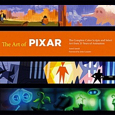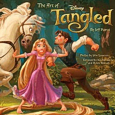 Amid Amidi is an author, historian, and consultant, with numerous books to his credit. He’s the author of a Chronicle Books coffeetable book celebrating the 25th anniversary of Pixar that was just published, and is writing a biography that will also be published by Chronicle in mid-2012. He is the youngest recipient of the prestigious Theatre Library Association Award which he received for his book Cartoon Modern: Style and Design in Fifties Animation (2006, Chronicle Books).
Amid Amidi is an author, historian, and consultant, with numerous books to his credit. He’s the author of a Chronicle Books coffeetable book celebrating the 25th anniversary of Pixar that was just published, and is writing a biography that will also be published by Chronicle in mid-2012. He is the youngest recipient of the prestigious Theatre Library Association Award which he received for his book Cartoon Modern: Style and Design in Fifties Animation (2006, Chronicle Books).
He has also written The Art of Pixar Short Films, The Art of Robots for 20th Century Fox about the making of the Fox/Blue Sky computer animated feature, and edited and designed the book Inside UPA, a compilation of unpublished photographs from the legendary UPA Animation Studios.
In March 2004, he partnered with Jerry Beck and launched the Cartoon Brew website and in March 2007, they debuted the animation-on-demand download site Cartoon Brew Films. In September 2008, they launched Cartoon Brew TV, an exclusive on-line showcase for the world’s finest contemporary animated shorts.
Amid has curated retrospectives and presented lectures at the Ottawa International Animation Festival (Canada), Elektra: International Digital Arts Festival (Canada), Anima Mundi (Brazil), Fredrikstad Animation Festival (Norway), Projector Festival (Scotland), Platform International Animation Festival (Portland), Los Angeles Times Festival of Books, Comic-Con International in San Diego, and the 2D Animation Expo (Los Angeles). He has served on award juries for the following festivals: Fredrikstad Animation Festival (2008), Ottawa International Animation Festival (2009), and Animation Block Party (2010). Additionally, he has worked in the animation industry in a number of capacities, and consulted for various media/entertainment companies.
We spoke to Amid about his latest trip to Pixar for The Complete Color Scripts and Select Art from 25 Years of Animation!
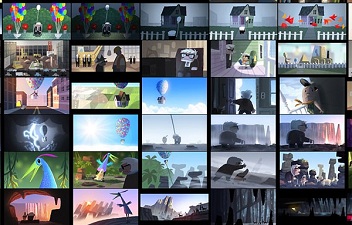
Animated Views: What led you to animation?
Amid Amidi: I watched cartoons like every other kid growing up, but I continued enjoying them as I grew older. I received a copy of Chuck Jones’s autobiography Chuck Amuck when I was still at an impressionable age, and my interest shifted to the artists behind-the-scenes who created the animation. And so I started studying the process and learning how animation worked when I was in my teens.
AV: How did you approach this book that is at the same time a book on Pixar color scripts, and an “anniversary” book on Pixar art?
AA: The idea for the book was largely established by the time I came on board. Leigh Anna MacFadden at Disney Publishing and my editor at Chronicle, Emily Haynes, both played important roles in designing this approach. It wasn’t your standard take on an anniversary book, which intrigued me. They wanted to showcase as much work by Pixar artists as possible, and of course, I thought that was great.

AV: How did you approach this book regarding your former Art of Pixar Short Films book?
AA: I spent a while at Pixar just as I did with the previous Art of Pixar Short Films book. It’s a real pleasure to be able to spend time with such talented artists and learn about their work.
AV: When doing a book on 25 years of art, where do you start from? How did you choose the concept art?
AA: Sometimes I’m heavily involved in the creative direction of books that I work on, but I can’t take credit for this one. The selections were chosen by the book designer, and the creative teams at Chronicle and Pixar. They’ve consistently shown good taste with their Art Of… books so I trusted they’d do a fine job with this book as well.
AV: How would you explain the art of color scripting?
AA: Color scripts serve a functional purpose in animation. Due to the nonlinear production process of computer animation, the director needs all the clues he can get as to what the finished image might look like on the screen. The color script is an early attempt to map out the color, lighting, emotion and moods in a film. It’s not about making a single pretty piece of art; the color script evolves throughout the early stages of the film, hand in hand with story development.
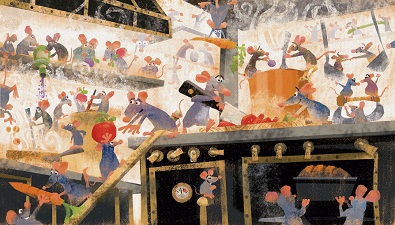
AV: Do you think color scripts can help make a “better” movie?
AA: The more ways a director can see their film, the better. By itself, a color script won’t make or break a film. But it can definitely help the crew evolve their ideas and figure out different approaches to the story they’re telling.
AV: Could you elaborate on the great comparison you make in your book between color script and music composition?
AA: That concept came from Natalie Kalmus who supervised the color of live-action films at Technicolor during the Golden Age of Hollywood. When she compared color scripting to music composition, I think she was simply saying that a film’s color works better when it follows a clear path from start to finish. Sometimes there is a tendency to view color as an afterthought, but those who plan their color and exploit its possibilities can create a richer and more emotionally engaging film experience for their viewers.
AV: Many color scripts rely on pastel as a medium, even digital. How do you explain that?
AA: The person who brought color scripts to Pixar was Ralph Eggleston, and he made the first one for Toy Story in pastel. That tradition stuck for years afterward, largely because pastel is a very fast and efficient medium to work in. Today, most of the color scripts are done digitally because digital painting is even faster than pastels.

AV: You quote Monet and Matisse. How close, to you, is animation studio art to classic art?
AA: Art is art. Animation is a relatively new and different form of artistic expression, but the best animation artists are as talented as artists working in any other medium, including classical painting.
AV: How do you explain that, in the beginning, animation studio artwork was considered just good enough to be sold as a souvenir at the exit of Disneyland attractions, and that now it’s presented in books and in the greatest museums of the globe?
AA: The fact that we have these coffee table books today is a wonderful stroke of luck because for decades nobody considered this production art worth saving. And to a certain extent, that’s understandable because the finished piece of artwork in animation is the film itself. Everything else is a byproduct of the process. It’s a testament to the growth of the art form that the general public now wants to see pre-production and production artwork from these films. Yet it’s important to remember that nobody would want to see this art if the films themselves weren’t any good. We shouldn’t forget that all the artwork in these books aids the creation of moving pieces of art.
AV: What are your favorite Pixar feature and short?
AA: I love the original Toy Story and The Incredibles, but I don’t like simplistic labels like calling something a favorite. Even if I don’t like the overall film, I appreciate aspects of every movie I see.
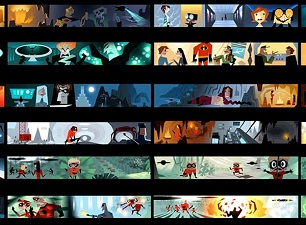
AV: Do you have any favorite color scripts, then?
AA: Again, I don’t know if I have a favorite, but I’m impressed by Bill Cone’s colorscript for Cars and Ralph Eggleston’s colorscript for Wall-E. They hold up as beautiful artwork in their own right, and each time I revisit them, I see something new.
Scripts And Select Art From 25 Years Of Animation
is available to order now from Amazon.com
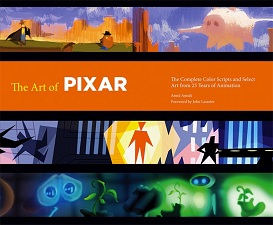
Our thanks to Amid Amidi and April Whitney


